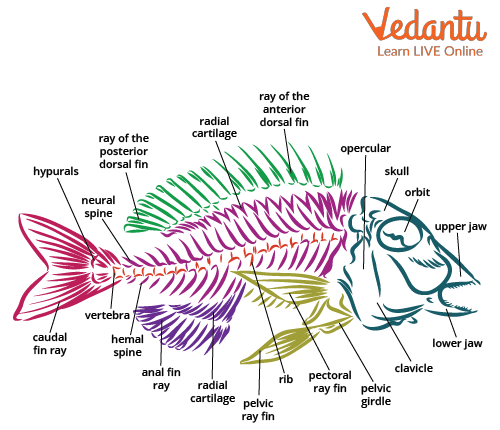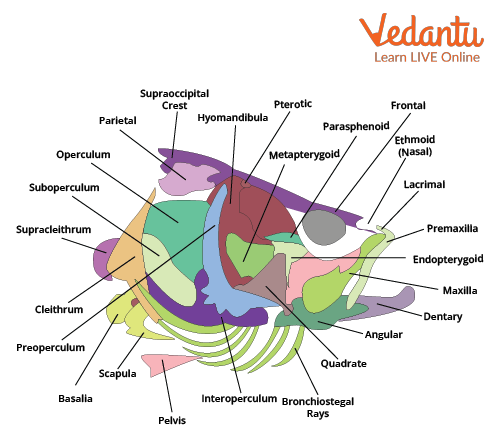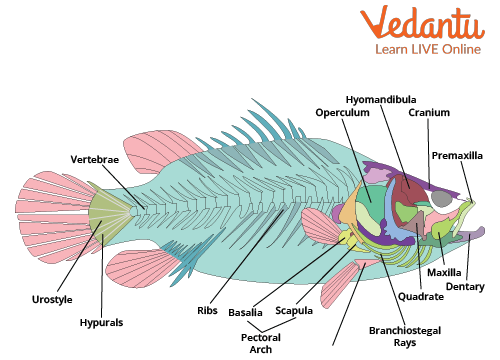Why the Fish Skeletal System Matters in Biology
The structure of bones and cartilage that supports the body is known as the fish skeletal system. A fish is an aquatic and vertebrate animal. It has a well-developed skeleton system that helps in the formation of body structure. Even more basic is the skeleton of the Hagfish. Although the skeletons of sharks and rays are more complicated, they are still mostly made of cartilage rather than bones.
What is Skeleton?
A particular organism's skeleton is a typically stiff supporting or protecting structure or framework. The internal organs of a vertebrate are supported by and protected by a bony or mostly cartilaginous framework.
Fish Skeleton
Fish have vertebrae. The vertebrae, which make up the spine, have bone or cartilage that surrounds the dorsal nerve cord. A fish skeleton is formed of bones and cartilage. Some fish which are formed of only bones are called bony fishes, while those formed of cartilage are called cartilaginous fishes.
The predatory fishes in the class Chondrichthyes include sharks, rays, skates, and ratfishes. They have jaws and paired fins. Many of them have their skin covered by a special form of scale, and their skeleton is composed of cartilage rather than bone. These are cartilaginous fish.
Structure of Fish Skeleton

Skeleton of Fish
Fish Bones
Bones may recover on their own and become stronger than the original bone since they are made of tissues that include blood vessels and nerves. The skeleton system of a fish has many small bones. Approximately 150 bones are present in the skeletal system. The bones are dense, less flexible connective tissue.
Vomer: On the roof of the mouth is the vomer midline bone, which typically supports teeth.
Maxillary: Paired bones are located behind or above these bones (toothed primitively).
Articular: A moveable joint is formed dorsally by a pair of paired, angular-shaped bones that are articulated and take up a portion of the lower jaw's posterior end.
Retro Articular: Paired bones are located at each articular's lower posterior corner.
Dentary: Large paired dental bones that are united medially and create the lower jaw's front (toothed).
Opercle: Flat, paired, and connected to hyomandibula bones form the majority of the gill cover.
Centrum: The centrum, the central, cylindrical component of each vertebra, obstructs the embryonic notochord during ossification.
Scapula: They are a pair of flat bones that articulate with the cleithra posteriorly and the coracoids anteriorly. The cleithra and scapula articulate with the coracoid paired bones. Small bones, called radials, connect the fin rays; they articulate anteriorly with the scapula and coracoid bones.
Fish Skull
The skull is also known as the cranium. The fish's skull is really a double construction made up of two bone "boxes" that are encased in one another.
Dermal bone forms the outer shell of the skull. Endochondral bone makes up the inside of the skull. On the surface of the gills, there is an operculum. First, on top of the gills, is the preoperculum. The premaxilla is very close to the mouth. Second, in the mouth, after the palatine are the maxillae. The jaw's bottom is called the dental, and between the palatine and the dentary lies the angular. Between the palatine and hyomandibular is the quadrate, while the hyomandibular and cranium are joined. The mouth roof refers to the palatine.

Skull Anatomy of Fish
Function of Skull
Fishes have a cranium (skull), which protects the brain. The skull covers the brain and protects it from any injury and shock.
Vertebral Column
The vertebral column is made up of a number of endochondral bones known as vertebrae. The centrum of one is the enormous spool-shaped core region. The trunk and the tail are the two sections of the fish’s vertebral column. Fish ribs are attached to the spinal column in the trunk region.
Pectoral and Pelvic Girdle
The pectoral fin is connected to the fish skeleton by the pectoral gridle. The pelvic girdle joins the fish skeleton to the pelvic fin. The pelvic girdle is free-floating and not connected to the spinal column or the pectoral girdle.
Types of Skeleton
There are two basic kinds of skeletons:
The exoskeleton, which serves as an organism's sturdy exterior shell, and
The endoskeleton, which provides the body's internal support system. The exoskeleton has scales of fishes.
An animal's internal support system, or endoskeleton, is made of tissue that has undergone mineralisation. The skin or deeper bodily tissues are where the endoskeleton develops. Essentially, a vertebrate has an endoskeleton consisting of two different types of tissues (bone and cartilage). Exoskeletons are skeletons that are external to the animal and are created to protect certain bodily parts.
Parts of the Skeleton
A fish is a vertebrate, and vertebrate skeletons may be generally classified into two axial and appendicular skeletons. The skull, vertebrae, and ribs make up the axial skeleton.
The pectoral and pelvic girdles, as well as the bones of the appendages, make up the appendicular skeleton.

Fish Skeleton System
Function of Skeleton
It provides a framework and support that surrounds and supports the body's soft organs. The heart, lungs, and brain are among the fragile organs that the skeleton protects. It aids in bodily movement, and muscles use bones as levers. The bone is a component of the skeleton and aids in the storage of minerals like calcium and phosphate. Bone marrow in the bones aids in the production of blood cells.
Conclusion
Fishes are vertebrates and have bones and cartilage in their skeletal system. This skeletal system helps to make the framework of fishes. The fishes can be bony fishes in which only bones are present or can be cartilage fishes in which only cartilages are functional to form a skeleton.


FAQs on Fish Skeletal System: Structure, Parts, and Functions
1. What exactly is the skeletal system in a fish?
The fish skeletal system is the internal framework that provides the body with support, protects vital organs, and serves as an attachment point for muscles. Unlike humans, a fish's skeleton can be made of either cartilage (like in sharks) or bone (like in a tuna). This entire structure is an endoskeleton, meaning it is located inside the body.
2. What are the main parts of a fish's skeleton called?
A fish's skeleton is primarily divided into two main sections:
- The axial skeleton, which includes the skull, vertebral column (the backbone), ribs, and supports for the tail fin. This forms the central core of the fish.
- The appendicular skeleton, which consists of the internal supports for the fins, including the pectoral and pelvic girdles that connect fins to the body.
3. How does the type of skeleton help in classifying fish?
The material of the skeleton is a key feature used to classify fish into two major groups:
- Chondrichthyes (Cartilaginous Fish): This group includes sharks and rays. Their skeletons are made entirely of cartilage, a strong but flexible tissue.
- Osteichthyes (Bony Fish): This is the largest group, including fish like carp and salmon. They have a skeleton made of true bone, which is harder and more rigid than cartilage.
4. Do all fish actually have bones?
No, not all fish have bones. While most common fish are bony (Osteichthyes), a major group called cartilaginous fish (Chondrichthyes) lacks true bones entirely. Their skeletons, including the skull and spine, are made of cartilage. Sharks, skates, and rays are well-known examples of fish without bones.
5. Why are the small bones found in fish meat often sharp?
The fine, sharp bones, sometimes called pin bones, mainly serve a protective function. They act as a natural defence mechanism against predators. When another animal tries to eat the fish, these sharp bones can make it a difficult and unpleasant meal, which helps deter the predator. They also provide extra support for the fish's muscle structure.
6. How is a fish's skeleton adapted for moving in water?
The fish skeleton is perfectly designed for aquatic life. Its flexible vertebral column allows the body to make S-shaped movements, propelling it through the water. The fins, supported by the appendicular skeleton, act like rudders and stabilisers for steering, stopping, and balancing, making their movement highly efficient.
7. What is the difference between an endoskeleton and an exoskeleton, and which type do fish have?
The key difference is location. An exoskeleton is a hard outer covering, like the shell of a crab. An endoskeleton is an internal support framework. Fish have an endoskeleton, made of either bone or cartilage. While fish also have scales on the outside for protection, these are part of the skin and not the main skeletal system.










